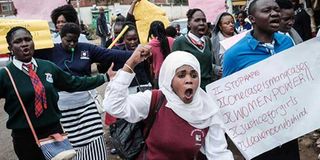Student sexual abuse goes beyond headlines

Activists in school uniforms protest against the alleged rape of three girls at Moi Girls School Nairobi. Student-on-student sexual assault and harassment happens with alarming frequency in our educational institutions. PHOTO | JEFF ANGOTE | NATION MEDIA GROUP
What you need to know:
- While adult-on-child sexual assaults on school property rightfully claim the headlines, student-on-student cases are more common.
- The number could be much higher as cases are under-reported or mislabelled as bullying.
- The school setting is one of the first places where children learn to relate to and interact with one another.
It’s unnerving but student-on-student sexual assault and harassment happens with alarming frequency in our educational institutions. Whether in bathrooms, on school playgrounds or in the back of the school bus, it happens.
While adult-on-child sexual assaults on school property rightfully claim the headlines, student-on-student cases are more common.
The number could be much higher as cases are under-reported or mislabelled as bullying.
That is why the team that Education Cabinet Secretary Amina Mohammed formed to develop a policy to address sexual and other abuses in schools has its job cut out for it.
Education is vital. It provides opportunities for personal, social and academic development and future employment and integration in society.
LEARN TO RELATE
The school setting is one of the first places where children learn to relate to and interact with one another. It is often in relation to their peers that they begin to perceive themselves and their environment — which can have a major effect on self-image, self-esteem and development.
But again, the culture of an educational setting will usually mirror the values and attitudes of the society. So, even as we lament the rising cases of student sexual harassment in schools, there is every reason to think about the values we impart on our children.
Young people who are regularly exposed to sexualised, degrading images of girls and women and rigid sex-role stereotyping may not recognise sexual harassment and may participate in it without realising its implications.
RAISE AWARENESS
The country needs a major campaign against rape and other sexual abuses to raise awareness about this serious challenge in our schools and other institutions and society in general. We must educate the public, students and staff in our institutions alike on the prevention of rape, domestic violence, dating violence and sexual assault and stalking.
On this, we can’t rely on parents as the conversation between parents and children ends at stranger danger.
We should provide a general education for all high school students and staff and then a small pool of students — identified and selected by educators because they are formal or informal leaders among the student body — receive a more extensive training that includes bystander intervention methods.
Investigating sexual assault requires real skill and training.
Guidelines for what to do in case a student is suspected to have been sexually assaulted should be clear. But such protocols are lacking, leaving schools to interpret the issues on their subjective own.
The CS may want to mull over cyber-harassment — especially when an online comment or conduct amounting to sexual harassment is accessed through school technology or by private electronic devices on the premises.
Ms Omanga is a nominated senator and founder of Omangacare Foundation, an organisation that mentors and supports children and empowers women and the youth. [email protected]





